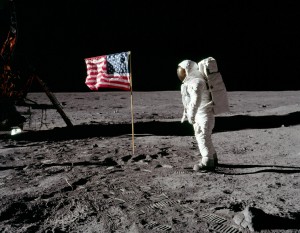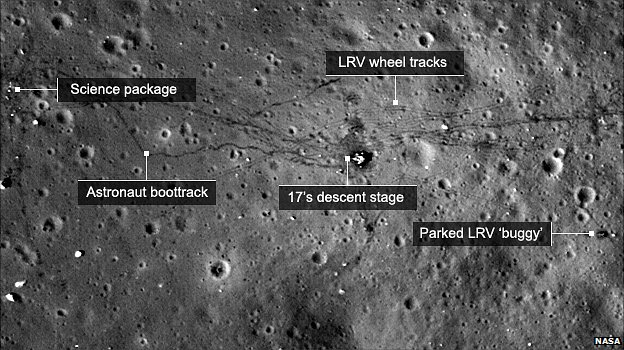Jul 21 2014
Moon Hoax Anomaly Hunting
 Yesterday, July 20th, was the 45th anniversary of Apollo 11 landing on the surface of the moon, and Neil Armstrong and Buzz Aldrin becoming the first and second humans to walk on the surface of another world. This is, to be sure, one of the greatest achievements of the human species.
Yesterday, July 20th, was the 45th anniversary of Apollo 11 landing on the surface of the moon, and Neil Armstrong and Buzz Aldrin becoming the first and second humans to walk on the surface of another world. This is, to be sure, one of the greatest achievements of the human species.
There are those, however, who claim that we never sent astronauts to the moon, that the entire thing was an elaborate hoax by the US, meant to intimidate our rivals with our spacefaring prowess. As is typical of most grand conspiracy theories, they have no actual evidence to support their claim. None of the many people who would have to have been involved have come forward to confess their involvement. No government documents have come to light, no secret studios have been revealed. There is no footage accidentally revealing stage equipment.
What the moon hoax theorists have is anomaly hunting. This is the process of looking for something – anything – that does not seem to fit or that defies easy explanation, and then declaring it evidence that the standard story if false. Conspiracy theorists then slip in their preferred conspiracy narrative to take its place. Sometimes they are more coy, claiming to be “just asking questions” (also known as jaqing off), but their agenda is clear.
Genuine anomalies are of significant interest to science and any investigation, no question. For an apparent anomaly to be useful, however, mundane explanations need to be vigorously ruled out (conspiracy theorists tend to skip that part). Only when genuine attempts to explain apparent anomalies have failed to provide any plausible explanation should it be considered a true anomaly deserving of attention.
At that point the answer to the anomaly is, “we currently don’t know,” not “it’s a conspiracy.”
The reason that anomalies, in and of themselves, are not very predictive that something unusual is going on, is that they represent one method of mining vast amounts of data looking for desired patterns. Conspiracy theorists, in essence, make the argument (or simply implication) that where there is smoke there is fire, and then offer apparent anomalies as the smoke. This is a false premise, however. If apparent anomalies count as smoke, then there is smoke everywhere, even without fires.
In other words, any historical event is going to have countless moving parts, curious details, apparent coincidences, and complex chains of contingency. Further, people themselves often have complex motivations contingent upon the quirky details of their lives. All of this is raw material for apparent anomalies. It would be remarkable if you couldn’t find apparent anomalies when combing through the details of an historical event.
Here are some of the alleged anomalies that moon hoax conspiracy theorists have pointed out over the years. One major category is photographic. They point to the lack of stars in the moon’s sky, the visibility of astronauts with the sun behind them, and the non-parallel shadows of different objects lit by the same source.
These all derive from the fact that the moon is an unfamiliar location for photography. These apparent anomalies all have simple explanations. The stars are simply washed out. The landscape is uneven, hence the non-parallel shadows. And the moon’s surface is highly reflective, providing the fill light to make the front of astronauts visible even when the sun is behind them.
Another unfamiliar property of the moon is the lack of atmosphere, allowing the flag to flap for a long time once moved by an astronaut. Without air to dampen the oscillations, they continue.
One more technical point often raised is the claim that the astronauts would have been killed by radiation from the Van Allen belts and cosmic rays. This is simply untrue, however. The Apollo 11 astronauts received a total of about 11 millisieverts of radiation, with a lethal dose being about 8,000 milisieverts (or 8 sieverts) NASA’s limit for lifetime exposure to radiation is 1 sievert, about what astronauts would get on a one-way trip to Mars. What saved the Apollo astronauts was the brief total overall time exposed to radiation. The longest Apollo missions lasted 12 days.
Beyond the lack of evidence for a conspiracy, and the non-anomaly anomalies, there is a huge plausibility problem with the moon hoax conspiracy. Why haven’t other countries, like Russia, ever come forward with evidence that their tracking does not support NASA’s story? Where did all the moon rocks come from (and don’t say meteorites, those would look different due to their travel through the atmosphere, and we would never have found so many from the moon).
It’s unlikely the US could have pulled off the hoax, and some have argued it would have actually been easier to just send astronauts to the moon.
There is also undeniable evidence that there are human artifacts on the moon. Anyone with the equipment and knowledge can fire up a laser and bounce the beam off a corner reflector left on the surface of the moon.
 Conspiracy theorists long have said that if we went to the moon, why are their no pictures from telescopes. Well, telescopes do not have the resolving power, but moon probes do. The Lunar Reconnaissance Orbiter has taken pictures of multiple Apollo landing sites, showing equipment left behind, and the tracks made by the astronauts.
Conspiracy theorists long have said that if we went to the moon, why are their no pictures from telescopes. Well, telescopes do not have the resolving power, but moon probes do. The Lunar Reconnaissance Orbiter has taken pictures of multiple Apollo landing sites, showing equipment left behind, and the tracks made by the astronauts.
Conclusion
The evidence is overwhelming and undeniable that NASA sent multiple missions to the moon, leaving behind footprints and equipment and bringing back moon rocks and history.
Conspiracy theorists, however, deny the undeniable with flimsy and easily refutable claims of alleged anomalies. They have no evidence to support their theory, and cannot put forward even a coherent narrative. They do tell us something about the human capacity for motivated reasoning and self-deception.
In a way, therefore, the Apollo missions (with their attendant conspiracy theories) represent the best and worst aspects of human potential.






